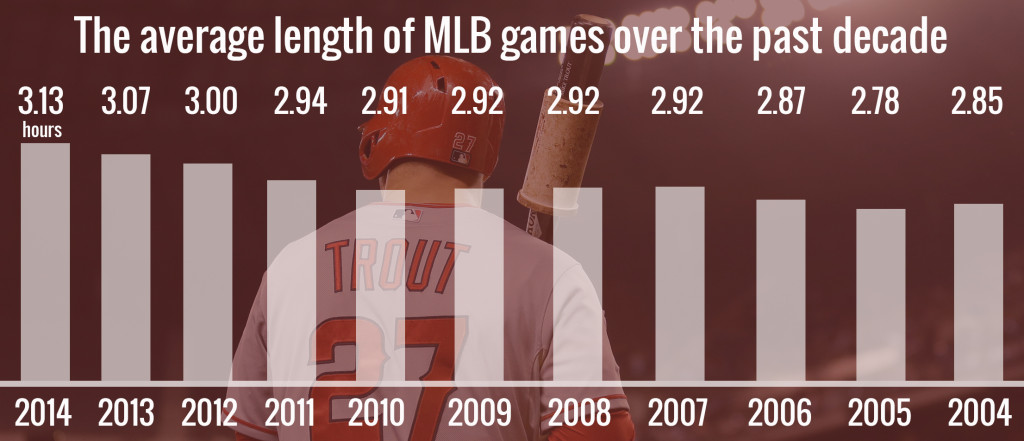Tags
A Prediction for MLB in 2015, baseball, New Rules for 2015, Speeding up the Game, Spring Training
I was in Jupiter, FL Monday and Tuesday to take in a couple of Spring Training games, and I noticed something that I suspect we’ll see continue in the regular season this year.
Now I know, Spring Training is not indicative of the regular season. And you can find at least a dozen reasons to question what I’m about to say. But if I were a betting man — and I have been known to make an occasional wager on both baseball (and blackjack) — I would bet on the following statement:
In 2015 the average length of MLB games will be drop between 5-10 % from its 2014 average.
Most of you know there are a few new rules this year to try to get control of the length of the games and reverse the trend that you can see in the chart below. (The two most obvious new rules: one, an on-field clock — yes, a clock in baseball — that displays the time between pitching changes and also the time between innings; and second, batters must keep one foot in the batter’s box and thus cannot step out of the box between every pitch.)

Now I’ve never been one to complain about length of games. After all, for my money, a day or night at the ball park has never been about how long I’m there. It’s about the game, and especially the game within the game.
That said, I have found myself annoyed when my heroes Dustin Pedroia and David Ortiz step out of the batter’s box between every pitch and adjust their batting gloves, etc. I think batters should bat and pitchers should pitch, with a minimum of time between those two ‘events’. Let’s get on with the game.
If a game goes 10-12-15 innings, so much the better. I love it that there’s no clock that determines the end of the game. One team has to score more than the other for a game to end. It’s one of the few sports where that is the case, and it’s part of the allure of the game for me.
One of the first things I noticed when the Sox played the Cards on Monday (after I got over being pissed that the Sox only brought two starting day players) was that the game moved along quickly. The pitchers got to the mound quickly, and the batters stayed in the batters’ box between pitches. The game took 2 hours and 28 minutes.
The next day it was the Nats against the Marlins (again with almost no starting day Nats’ players on the field or in the dugout), but the game moved along quickly. This time it was 2 hours and 32 minutes.
An oddity?
I checked the times of the nine games the Sox have played so far this spring (not including the two shortened ‘openers’ against BU – 2:07 and Northwestern – 1:45). Six of the nine were concluded before the three hour mark. The time of the games: 3:07, 2:52, 2:44, 2:51, 3:10, 2:28, 2:32, 3:14, 2:51.
So I looked a bit further. I checked and found that in the 101 Spring Training games played through Mar. 11, more than three-quarters (76.2%) of the games were concluded in less than three hours. Only 24 of the 101 games took three hours or more. And even those games usually did not last longer than 3:10. Many of the shorter games were in the 2:30 range.
Now there are lots of reasons for shorter games in Spring Training, but most of the 101 games went the full nine innings; only a very few were called for being tied after nine. Lots of other reasons for quicker games too, I know, but simply observing the two games I saw, the two rules mentioned above certainly seemed to speed up the games.
Will this shortened time carry over to the regular season?
I bet it does, and I bet it will be welcomed by the fans and the players, just as the instituting of the play review system seems to be winning over most fans and players, even those who were skeptical about those changes.
Anyone wanna bet?
** ** ** ** ** **
Also, get your predictions in for the 2015 MillersTime Baseball Contests


The Duke of Brooklyn said:
You have far too much time on your
Hands!
Go be a Grandad!
ME
Jim Cooke said:
Great reporting! I had hoped the new rules would eliminate interminable stalling tactics of players and managers. I’m all for the new rules.
romana campos said:
I didn’t know about those two rules. Thanks for educating me. Ed knew it, of course, but I’m on a need to know basis, so thanks for the update. By the way, I hope you have your little banner or picture up that says “We interrupt this family for baseball season.” We are so excited to be returning right when baseball season starts. Are you going to the opening game? If so, lucky you!!!